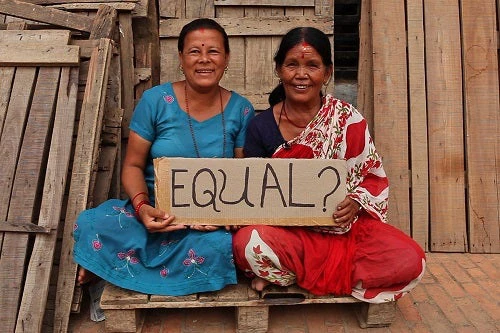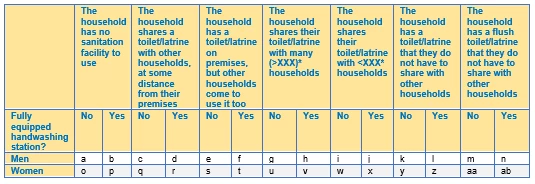Women and girls are particularly affected by the lack of safe and accessible water, sanitation and hygiene (WASH). They suffer during menstruation and childbirth, and also carry the burden of hours spent collecting water when is it not easily accessible, causing them to miss school and risk rape and harassment. To address this, women and girls are emphasized in Sustainable Development Goal (SDG) #6: “By 2030, achieve access to adequate and equitable sanitation and hygiene for all and end open defecation, paying special attention to the needs of women and girls and those in vulnerable situations.”
While anecdotal evidence is important — and well known — it is critical to also collect data and indicators to quantify the problems, to sensitize and inform stakeholders, and ultimately, to find solutions. However, we are struggling with a global lack of monitoring to collect such data.
The paper “What can existing data on water and sanitation tell us about menstrual hygiene management?” is short-listed in the recent Waterlines’ Jeroen Ensink Memorial Prize, commemorating the efforts of Dr. Ensink to improve the lives of those who today still live without access to safe drinking water and sanitation.
Data where sex or gender differences might be inferred
Through such data, we understand that menstruating women are likely to have a less private and a more stressed experience when confronted by water scarcity and poor sanitation than their male counterparts. The article presents global and national estimates for 10 countries picked from the World Bank’s WASH Poverty Diagnostic, currently underway.
We found some striking data:
- Half a billion women globally, or 13% of all women, lack a place to defecate, and likely lack privacy for menstrual hygiene management (MHM).
- 197: Number of countries for which such estimates were available in 2015.
- Data on handwashing suggests, by proxy, that lack of cleansing materials is a particular challenge for MHM. In six out of ten countries with available data, over 3/4 of women lack access to soap and water.
- 54: Number of countries for which such estimates were available in 2015.
Is it useful to estimate what percentage of girls or women live in a household who generally travel some distance to use a pit latrine that any stranger can walk into? We can calculate that. The categories “w” and “x” below represent it. The further distinction between “w” and “x” is whether or not they also lack a fully equipped handwashing station, an additional obstacle to menstrual hygiene management. Data on that, and each of the 28 measurements, is available for many countries, by background characteristics including subnational region, urban vs rural, ethnicity, religion, and wealth status.

*”XXX” is used to signify that as the surveys record how many households share the toilet/latrine, and there is not yet widespread consensus on the best number to use, this can be replaced in analysis with a specific number.
More data and direct measurements are also needed to better target solutions to women and girls. Since first deploying these measurements in Belize, the MICS are now rolling out new measurements for women and girls who menstruate, asking them:
- When did your last menstrual period start?
- Was the last menstrual period within last year?
- Due to your last menstruation, were there any social activities, school, or work days that you did not attend?
- During your last menstrual period were you able to wash and change in privacy while at home?
- Did you use any materials such as sanitary pads, tampons, or cloth?
- Were the materials reusable?
What happens beyond the household — in schools and health centers?
Under the SDGs, the WHO/UNICEF JMP — the responsible agency for the monitoring of SDG 6.1 and 6.2 — plans to shine a light on WASH challenges in locations that should be better prepared — such as schools and health care centers – as these facilities are a large part of an individual’s personal life and critical experiences.
The effects on women and girls
Looking to the bigger picture, it is worth noting that while some of the estimates mentioned here might help build an international picture of where and how inequities exist within the WASH experience, only the MICS question “ Due to your last menstruation, were there any social activities, school, or work days that you did not attend?” directly quantifies the potential effect on women and girls’ participation in society, education, and work. These large-scale surveys also collect information on well-being, life satisfaction, education, desire to have children, violence and harassment, feelings of safety walking alone at night, etc. Any patterns we might find here will hold clues to how a woman’s WASH situation can impact her broader life.
We will be sharing evidence we find on how gender or sex inequities in WASH correlate with broader life experiences and outcomes with you as our data grows.
- April 18, 2017, 2:30 — 4 pm (EST): Development Marketplace: Innovations to Prevent Gender-Based Violence
- April 20, 2017 @ 4:30 — 5:30pm (EST): Boosting Women's Economic Empowerment
- What can existing data on water and sanitation tell us about menstrual hygiene management?
- MICS questions: “Questionnaire for Individual Women (24 February 2017)”
- Questions recommended by the JMP for contributing to global monitoring in institutional settings


Join the Conversation